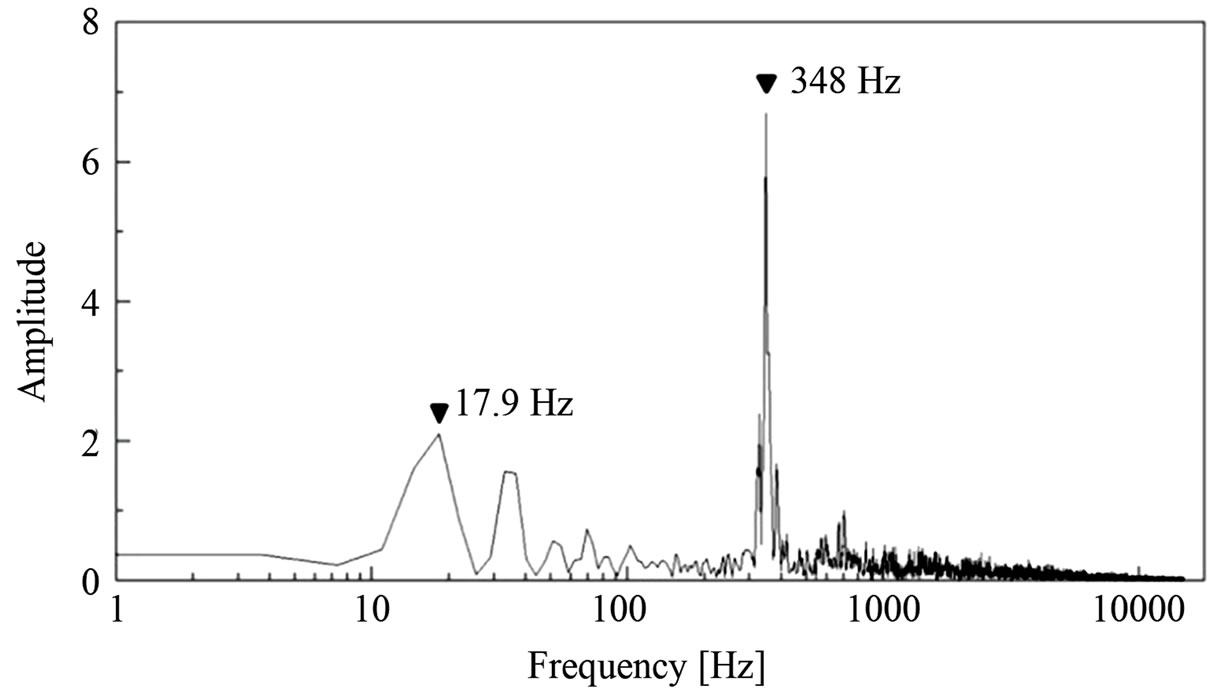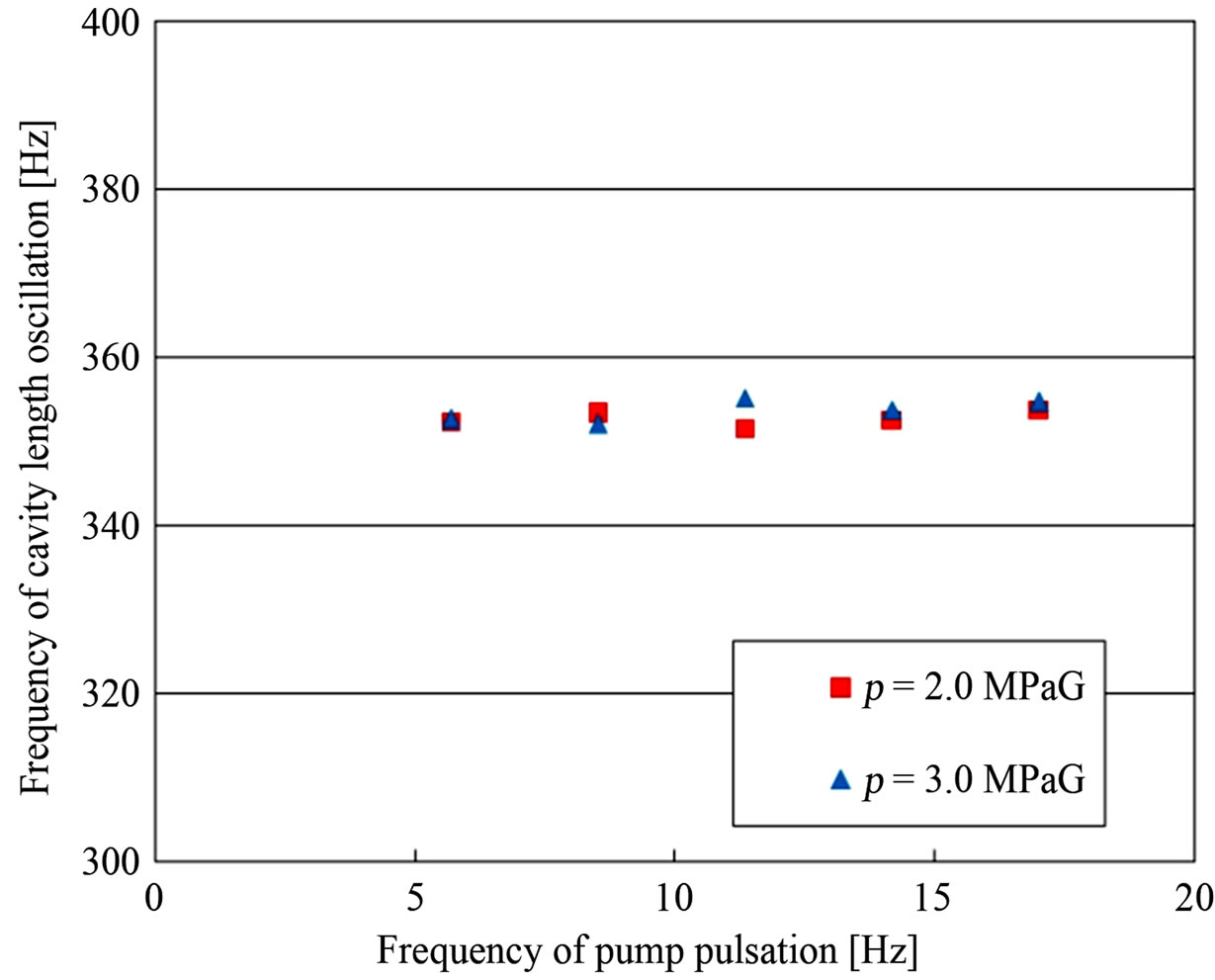High Speed Observation of Periodic Cavity Behavior in a Convergent-Divergent Nozzle for Cavitating Water Jet ()

Figure 6. FFT analysis for gray level change in cavity length at p = 2.0 MPaG.
 (a)
(a) (b)
(b)
Figure 7. Relation between upstream pressure fluctuation and behavior of cavitation cloud at p = 2.0 MPaG. (a) Change in cavitating zone and upstream pressure fluctuation; (b) Behavior of cavitation cloud due to upstream pressure fluctuation.
behavior of the cavity (cavitation clouds) at upstream pressure p of 2.0 MPaG. Water flows from the upper to the bottom side in the nozzle. Figure 7(a) shows an image analysis result and indicates the change of the cloud region. Figure 7(b) shows pictures about the growing and shrinking motion of the whole cloud region. Here, the black area indicates the existence of clouds under distance x from the nozzle throat inlet against elapsed time t. The elapsed time shown in upstream pressure fluctuation corresponds to that of the image analysis result.
From the results as shown in Figure 7, it is found that the cavity length grows longer when the upstream pressure becomes higher, that is, velocity increases higher (indicated by A and C in Figure 7(a)), and it grows shorter at lower upstream pressure B as shown in Figure 7(a). As a result, it can be confirmed that this kind of change in cavity length is affected by upstream pressure fluctuation as also shown in Figure 7(b). The frequency of upstream pressure fluctuation is almost equal to the rotational speed of the plunger pump. Thus, the upstream pressure fluctuation caused by the pulsation of the plunger pump has an effect on the periodic behavior of cavity length. Therefore, one of the main factors of periodic tendency in cavity length is considered to be upstream pressure fluctuation (and velocity fluctuation accompanied by upstream pressure fluctuation).
3.3. Periodicity of Growth and Collapse of Cavitation Clouds
On the other hand, it can be also recognized that the cavity (cloud region) length has shorter periodic oscillation as well as longer periodic oscillation indicated in Figure 4. In other words, the cavity length changes in a short time range, even when the upstream pressure fluctuation is relatively small. Figure 8 shows detailed successive still pictures taken by the high-speed camera. In these pictures, the collapsing, growing and shedding motions of cavitation clouds are shown at upstream pressure p of 2.0 MPaG and elapsed time t from 23.3 to 27.1 ms. Here, a time interval is chosen as 0.05 ms in the range from 25.1 to 25.9 ms, and is 0.2 ms in the other range. Figure 9 shows the frequency of cavity length oscillation for various upstream pressures p. The standard deviation of the data is estimated to be in the range ±15 Hz. In Figures 8 and 9, it is found that the cavitation clouds repeat a shrinking, growing and shedding motion with the frequency of about 350 Hz.
In Figure 8, the cavities appear at the nozzle throat exit (x = 10 mm) around t = 23.3 ms and then grow in the nozzle diverging area (t = 23.3 - 25.15 ms). Around time of 25.2 to 25.8 ms, it is found that the cavitation cloud is shed downstream and collapses near the nozzle exit (about x = 40 mm). After that, a reentrant motion is observed with a cloud shrinking upstream of the nozzle.

Figure 8. Cavitation cloud oscillation in the nozzle at p = 2.0 MPaG.

Figure 9. Relation between frequency of pump pulsation and cavity length oscillation.
When the reentrant motion reaches the nozzle throat exit (about t = 25.9 ms), growth of new cavity appears. Thus, the typical pattern of unsteady periodic behavior of cavity [6] can be also recognized in the present study.
As a result, it is observed that there is a shorter periodic behavior of cavity length accompanied with a shrinking, growing and shedding motion of clouds which is caused due to the cavitation cloud unsteadiness by nature [16,17], which is not affected by upstream pressure fluctuation due to the plunger pump. Here, the Strouhal number based on cavity length l (St = nl/u) is estimated to be about 0.28, where u is mean flow velocity at the nozzle throat and n is frequency of cavity length oscillation. Cavity length l is measured at the time right before the cavity breaks away and the shedding motion starts.
4. Conclusions
In the present study about the cylindrical convergent-divergent nozzle, the periodic behavior of unsteady cavitation clouds is investigated from a viewpoint of upstream pressure fluctuation caused by high pressure plunger pump using the high-speed video observation and the measurement of upstream fluctuating pressure.
The main results are as follows.
It is found that there are two patterns of the cavity length (cavitation cloud region) oscillations. One is due to the upstream pressure fluctuation caused by the high pressure plunger pump. The other is shorter periodic oscillation of cavity length. It is found that the shorter periodic fluctuation can be related to the characteristic oscillation of cavitation clouds accompanied with the shrinking (reentrant), growing and shedding motion of cloud.
The trigger mechanism of the reentrant motion remains unsolved at the present stage. As the next step, it is recommended to investigate about the relation between the reentrant motion and the pressure waves accompanied with the cloud shedding.
5. Acknowledgements
The authors would like to thank Dr. Yasuhiro Sugimoto and Dr. Kazuki Niiyama for their kind and helpful advice on this study.
Nomenclature
f = Frequency of inverter Fs = Frame speed of high-speed video camera l = Cavity length n = Frequency of cavity length oscillation p = Upstream pressure pv = Saturated vapor pressure of water p’ = Upstream fluctuating pressure St = Strouhal number, nl/u t = Elapsed time of experiment Tw = Temperature of water u = Velocity in throat part of nozzle x = Distance from throat entrance of nozzle
β = Dissolved oxygen content
ρ = Density of water
σ = Cavitation number, 2(p − pv)/ρu2